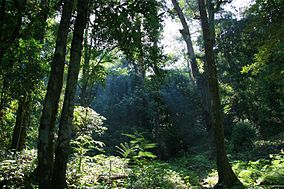Gunung Palung National Park
| Gunung Palung National Park | |
|---|---|
|
IUCN category II (national park)
|
|

Vegetation of Gunung Palung
|
|
|
Location of Gunung Palung NP in Borneo
|
|
| Location | West Kalimantan, Indonesia |
| Coordinates | 1°14′24″S 110°14′21″E / 1.24000°S 110.23917°ECoordinates: 1°14′24″S 110°14′21″E / 1.24000°S 110.23917°E |
| Area | 900 km² |
| Established | 1990 |
| Governing body | Ministry of Forestry |
Gunung Palung National Park lies on the island of Borneo, in the Indonesian province of West Kalimantan, north of Ketapang and east of Sukadana.
Gunung Palung was first protected in 1937 as a forest nature reserve covering 300 km2 (120 sq mi). In 1981, the size was increased to 900 km2 (350 sq mi) and its status raised to a wildlife reserve, and on 24 March 1990 the area became a national park.
The park is notable for its diversity of habitat types, ranging from mangrove and freshwater swamp forest, to lowland alluvial (empran bench) forest, to montane forest, and for its diversity of wildlife. It is one of only a handful of parks in the world where orangutans can be seen in the wild.
A research station (Cabang Panti) was established at the western foot of the main Gunung Palung mountains in 1985, and is owned and operated by the park management authority. Research there has contributed significantly to our understanding of Borneo forest biology.
Illegal, non-mechanized, 'hand logging' has been a problem in the park, especially from ca. 2000-2003. Initiatives by park authorities and NGOs (increased policing, monitoring by microlight, educational activities) contributed to a reduction of illegal activities, however, reduction of these activities has seen a resurgence in illegal logging at several hot-spots. The park was one of the key sites of the EU-funded Illegal Logging Response Center (ILRC, now continued in FLEGT).
In 1985 Dr. Mark Leighton established the Cabang Panti Research Camp deep within the National Park. The site encompasses over 2,100 hectares networked by over 25 km of well-marked trails extending throughout all seven forest types including the upper montane forest.
Following a short period of non-occupation from 2004-2007, Cabang Panti Research Station was rebuilt in 2007 with money provided by two research teams from the United States. Projects led by Dr. Andrew Marshall of the University of California at Davis and Dr. Cheryl Knott of Boston University funded the reconstruction. The current facilities include a main two-story wooden building complete with six private rooms, three office areas, a kitchen, living area and a mezzanine. Three out-buildings include one five-room bunkhouse for local research assistants, and two one-room houses for Principal Investigators. These buildings were donated to Gunung Palung National Park in 2011.
...
Wikipedia

